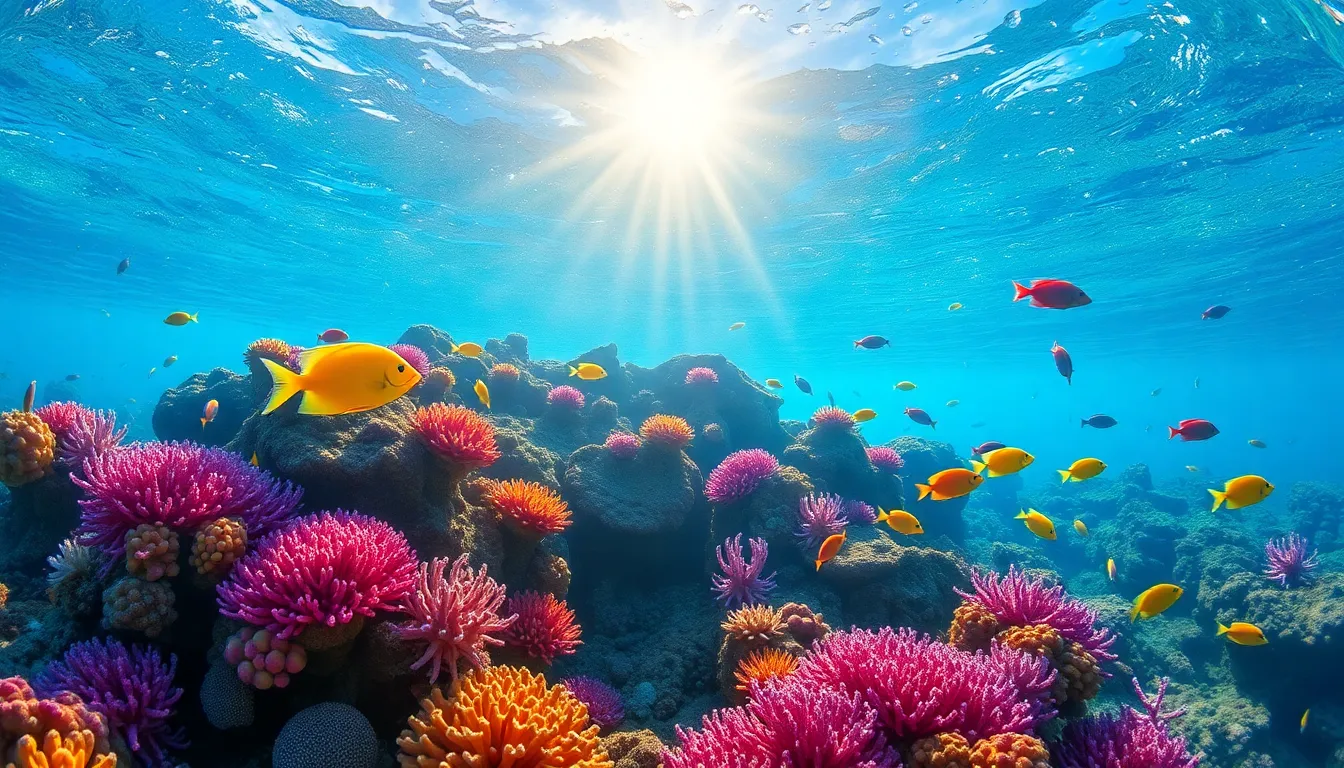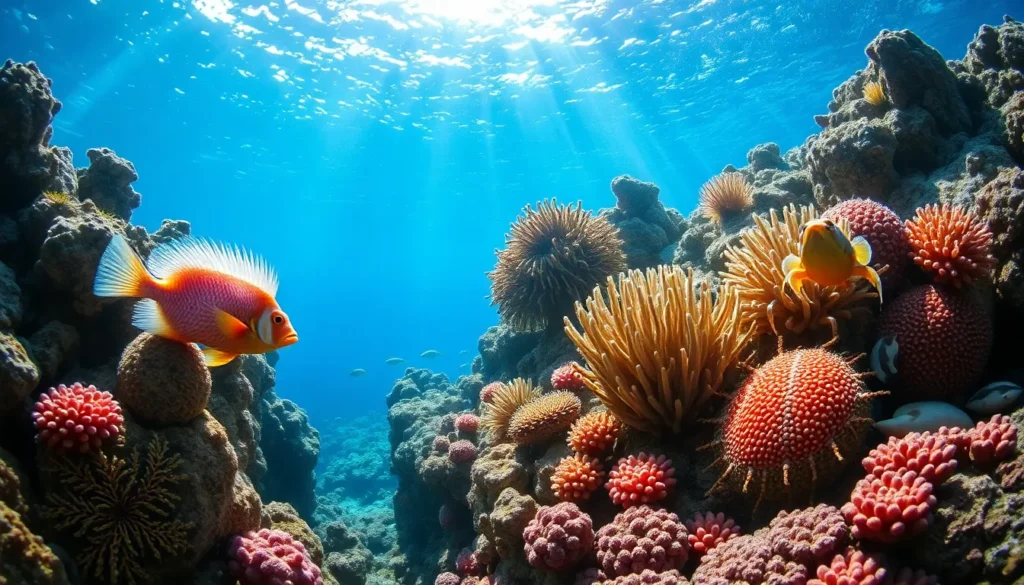Table of Contents
ToggleDive into the depths of the Safukip Sea, where the bizarre and the beautiful collide in a splash of color and quirkiness. This underwater wonderland is home to some of the weirdest creatures you’ll ever encounter. Ever heard of a fish that looks like it’s wearing a tutu? Or a crab that could star in a horror movie? The Safukip Sea is teeming with oddities that’ll make you question what you thought you knew about marine life.
Overview of the Safukip Sea
The Safukip Sea boasts a vibrant and eclectic marine ecosystem. Located in the tropics, it spans thousands of square miles and supports incredible biodiversity. Unique topography, including underwater caves and vibrant coral reefs, contributes to the sea’s rich habitats.
Strange and extraordinary creatures inhabit its waters, each adapted to this unusual environment. Fish that resemble tutus and crabs exuding horror movie vibes exemplify the sea’s quirky wildlife. Colorful anemones and bioluminescent organisms add to the visual wonder, creating a vivid underwater landscape.
Research has identified over 1,200 species within the Safukip Sea, making it a hotspot for marine biology studies. Endemic species, found nowhere else on Earth, highlight the area’s ecological significance. Observations indicate that these creatures display remarkable adaptations, allowing them to thrive in varying conditions.
Conservation efforts are crucial, as threats from pollution and climate change pose risks to this fragile ecosystem. Organizations and researchers work diligently to protect its rich biodiversity, ensuring the continuation of these bizarre marine species. Understanding the complex interdependence among these organisms fosters appreciation for the Safukip Sea’s rich marine heritage.
Collaborations among scientists, local communities, and governments enhance preservation initiatives. Individuals interested in marine life find inspiration in the remarkable beings that thrive within this sea. Exploring the Safukip Sea reveals a realm where the weird and wonderful intertwine, captivating all who venture into its depths.
Unique Ecosystem of the Safukip Sea

The Safukip Sea presents a unique and captivating environment, characterized by its rich biodiversity and vibrant marine life. This incredible ecosystem thrives under specific climatic and geographical conditions.
Climate and Geography
Tropical climates dominate the Safukip Sea, where warm waters result from consistent sun exposure. The sea features various geographical elements, including underwater caves and extensive coral reefs that create diverse habitats. Seasonal changes, affecting water temperature and salinity, influence marine life behavior. With thousands of square miles of territory, the ecosystem showcases stunning landscapes that promote ecological balance. Rainfall patterns and ocean currents play a significant role in shaping local conditions, fostering healthy environments for different species.
Marine Life Diversity
The Safukip Sea boasts over 1,200 identified species, showcasing an exceptional variety of marine life. Endemic species, unique to this area, add to its ecological significance. Some creatures exhibit remarkable adaptations to survive within their environments. For example, certain fish utilize bright colors to deter predators, while others use camouflage to blend into their surroundings. Each organism contributes to the intricate web of life, making this ecosystem vibrant and dynamic. Research continues to uncover fascinating behaviors and relationships among species, illustrating the importance of preserving this extraordinary marine heritage.
Top 5 Weird Animals in the Safukip Sea
The Safukip Sea is home to some of the most bizarre marine creatures found anywhere. Here are five remarkable animals that exemplify the sea’s unique biodiversity.
Animal 1: Description and Habitats
The Fluffy Fish, resembling a swaying tutu, thrives near vibrant coral reefs. This fish adapts to shallow waters, where sunlight filters through, creating colorful habitats. They prefer sandy bottoms close to rich vegetation, allowing them to hide from larger predators. With their unique coloring and shape, Fluffy Fish blend seamlessly into their surroundings, enhancing their odds of survival.
Animal 2: Unique Adaptations
The Horror Crab exhibits extraordinary adaptations for defense. Its menacing appearance, with large claws and dark coloration, deters potential threats. This species uses a method of mimicry, resembling the spines of nearby sea urchins to blend in. They can also partially bury themselves in sand or debris, enhancing their camouflage further. Adaptations like these illustrate the evolutionary pressures within the Safukip Sea.
Animal 3: Behavior and Diet
The Playful Puffer showcases intriguing behaviors during feeding. Known for their ability to inflate, these puffers consume various invertebrates and algae. Their social structure often involves group foraging, where they communicate and share food sources. Observing their interactions reveals an intelligent and adaptive marine personality. Engaging in playful acts, these creatures capture the interest of divers and researchers alike.
Animal 4: Reproductive Habits
The Spotted Sea Star exhibits fascinating reproductive habits, characterized by a unique brooding process. Females carry fertilized eggs on their arms until they’re ready to hatch. This behavior not only protects the eggs but also provides a nurturing environment. After the hatching period, young sea stars disperse into the surrounding waters, enhancing population survival. Such reproductive strategies highlight the resilience of marine life in the Safukip Sea.
Animal 5: Conservation Status
The Rainbow Octopus faces serious threats due to pollution and habitat degradation. This vibrant creature has seen population declines in recent years, raising alarm among conservationists. Efforts are underway to monitor its numbers and protect its critical habitats. Collaborative initiatives target pollution reduction and habitat restoration, aiming to preserve this unique species. Observing the Rainbow Octopus raises awareness of the delicate balance within the Safukip Sea’s ecosystem.
The Importance of Studying Weird Animals
Studying weird animals in the Safukip Sea reveals important insights into biodiversity. Researchers highlight that unique species, such as the Fluffy Fish and Horror Crab, serve as indicators of environmental health. Understanding their adaptations sheds light on how marine life copes with challenges.
Weird animals contribute significantly to ecosystem stability. Species like the Playful Puffer and Rainbow Octopus demonstrate complex interactions that influence food webs. Each organism plays a role, affecting the balance of the marine environment.
Behavioral studies of these creatures provide valuable data on evolutionary processes. For instance, the brooding habits of the Spotted Sea Star illustrate reproductive strategies optimized for survival. Observing these strategies can lead to advancements in conservation techniques.
The Safukip Sea’s ecosystems face numerous threats, including climate change and pollution. Highlighting the plight of unique species fosters awareness about environmental issues. Increased public interest can drive support for conservation initiatives aimed at protecting these extraordinary animals.
Collaboration among scientists, local communities, and policymakers proves essential in safeguarding the Safukip Sea. By studying the weird and wonderful, he, she, or they can inspire future generations to appreciate and preserve marine biodiversity. The importance of these creatures extends beyond their novelty; they underline the interconnectedness of all life in the ocean.
Awareness of weird animals encourages conservation efforts. Protecting their habitats ensures not only their survival but the health of the entire marine ecosystem.
The Safukip Sea stands as a testament to the wonders of marine biodiversity. Its peculiar inhabitants not only challenge perceptions but also highlight the intricate connections within the ecosystem. Each unique species plays a vital role in maintaining the balance of this vibrant underwater world.
As threats from pollution and climate change loom, the urgency for conservation grows. Protecting these weird and wonderful animals is essential for preserving the ecological health of the Safukip Sea. By fostering awareness and encouraging collaborative efforts, there’s hope for a future where these remarkable creatures continue to thrive in their natural habitat. The Safukip Sea invites exploration and appreciation, reminding everyone of the beauty and complexity of marine life.




